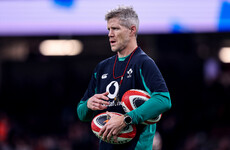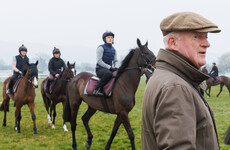THE LEINSTER SQUAD didn’t really know what to make of their new teammate. The quiet young lad from some small village in Meath looked almost too tall for his own body, and certainly didn’t seem to have the physicality required to play top-level professional rugby.
Some wondered if Devin Toner was good enough to make it at all.
He was. Today he will play his 262nd game for Leinster and become the province’s most-capped player of all-time, moving one clear of Gordon D’Arcy.
It’s an outstanding achievement for a man who never quite appeared destined for sporting greatness.
Toner grew up in Moynalvey, a small parish located midway between Dunshaughlin and Kilcock in nearby Co Kildare. Like the majority of towns in the south Meath area, there was not a lot of rugby to be found.
There was, of course, a GAA club. Starting off as the tall lad in goals, a remarkable growth spurt pushed the young Toner further and further up the field until he settled into the role of towering full-forward.
Paul Greene was a few years ahead of Toner in Moynalvey’s youth teams, and now acts as the club’s PRO.
“He was a grand young lad,” Greene says. “He wouldn’t have been that technically gifted but obviously his size was a big benefit in underage football.
“There’s a photo from an U14 final in 2000, and he’s towering above the referee. He was so big, managers were always asking for his date of birth or proof of his age.
“Even just before he went to the Leinster Academy, he was 15 or 16 playing minor football and he scored six goals in a game at full-forward. It was pump the ball into Dev, and then it was just one hand into the net.”
- For more great storytelling and analysis from our award-winning journalists, join the club at The42 Membership today. Click here to find out more >
To the relief of full-backs all around the greater Meath area, Moynalvey’s un-markable full-forward would soon be moving onto bigger and better things.
Toner had been introduced to rugby at North Kildare RFC as an U12 and had been making good progress. He continued his rugby education at Castleknock College, where, as Toner has himself admitted, “it really all started for me”. He was soon snapped up by Leinster and entered into their Academy programme.
“It would have been very rare for somebody from these parts to make a successful rugby career,” Greene adds.
“He was a tall, not so well-built lad heading off to play rugby in the Leinster Academy. Nobody here expected Devin as a 16 or 17-year-old to go off and be what he has become.”
At this stage rugby circles were still whispering Toner’s name in terms of potential, rather than talent.
Mark McDermott was double-jobbing at the time, filling the position of Ireland U21 head coach as well as being the IRFU’s Elite Player Development Manager, helping to oversee the transition from the national academy to provincial academies.
“At the tail-end of my playing career in Dublin I played in Lansdowne. The Quinn family, Charlie and Mick Quinn, were in Lansdowne and they had a very close affiliation in Castleknock,” McDermott says. “None of the Quinns are very quiet people, so you were kind of hearing a lot about this 6’10″, 6’11″ fella who was out there.”
McDermott decided he had to have a closer look, and it didn’t take him long to decide this raw second row had a big future ahead of him.
Some within the IRFU doubted Toner’s potential, but McDermott firmly believed he had everything required to become a top-level international. The Leinster Academy prospect was brought into the Ireland U21 squad at the age of 19.
“If you take any given decade of U21 players, there could be 20-25 people who play in the second row, so I was being asked; ‘Why is this guy different? And I used to say, ‘He’s different, and he’s going to play for Ireland. Simple.’
“He was the jewel in the crown for me (in that team). When you have a lad who is 6’11″, that doesn’t come along every day in Ireland.
“I was a huge fan of Devin, a huge, huge fan. Some people at that stage were saying, ‘Yeah he’s tall, but he’s skinny’… he wasn’t. He was about 120 kilos and he hadn’t done a proper conditioning day in his life. What a prospect – that was the way I looked at it.
You had this guy who had this physical profile that not just fitted, but exceeded the profile of the modern day second row. And in my opinion he had the athleticism to go with it. So I was saying great, you’ve got a blank canvas with this fella. Let’s see where it will go.”
At Leinster, some of his new teammates were more sceptical, at least initially.
Reggie Corrigan was nearing the end of his own playing career when Toner first arrived on the training pitches out in Donnybrook. While Toner may have looked the part against those his own age, the hardened senior pros at Leinster held different standards when it came to the necessary physical requirements.
“I remember there was quite a bit of wonderment about him, because we had never seen anything like him in terms of his height,” Corrigan says.
“Also, I distinctly remember thinking he was a bit like Bambi. He was kind of so big and tall that he didn’t almost fit his body, he hadn’t grown into it as such. Whilst he was very tall, he certainly wasn’t very physically strong yet. He didn’t have the muscle mass or any of that stuff.
“I was thinking to myself, I wonder will this lad be able to make it at all, because he just didn’t seem to be quite strong enough to progress to the next level.”
***
January 27, 2006. An otherwise forgettable 62-14 win over Border Reivers will become a notable footnote in Leinster rugby history. With 15 minutes to play, a 19-year-old Devin Toner comes on to make his senior debut. As the game enters the final 10 minutes, head coach Michael Cheika throws in another young debutant, Johnny Sexton. There are just over 4,000 supporters in attendance.
Toner would have to wait four months for his next taste of senior rugby, getting five minutes against Edinburgh. His 2005/06 season ends with a total of 20 minutes on the pitch. He would make four appearances the following season and just six the year after that.
While Cheika obviously saw something in him, at that stage he was more inclined to focus his energies on the club’s more established, senior stars. Toner was left to work on his physique while also lining out in the more forgiving surroundings of the AIL with Lansdowne.
“The potential that people saw in him was huge, and everybody spotted that, but they knew there was also a lot of work to be done, and that he would need to do a lot of work himself,” Corrigan says.
“He was this long, bendy, uncoordinated type of fella. You would look at him and think ‘Jesus, how would that fella even put it together to make a run?’
“Now he’s twice the size he was in terms of muscle mass, but he’s able to use it. You see Devin carrying ball and things like that now, which in the early days, if he did that, lads would just melt him with a tackle, because he was so big you were able to get in underneath him and he didn’t have any size to back it up.
“They had a find a way to get him developed in all those other areas. And they did to be fair. They were quick off the mark in getting him up to speed and putting him on good programmes, getting him bulked up putting on muscle mass.”
At the same time as Toner was making his first tentative steps with Leinster, McDermott was working with him regularly in his Ireland U21 squad, in the last year before it would change to U20.
“When we had him at U21s level, he was 19, 6’11″ and probably somewhere in between 115-120 kilos. Now in layman’s English, that’s a lot of weight.
“Obviously when you have a frame like his there is huge scope for enlarging that even more, and his entry into full-time professional rugby enabled him to max out the growth in that body. The other side of it is learning how to use that body.
“When you are that tall and you are initially learning how to carry the ball into contact, it is difficult to get low. There was a period of time when sometimes when Devin was ball-carrying, it might not have been as effective, as a result of his height, because that’s a pretty big target to hit if he’s upright.
“I think he realised – ‘Oh shit, I’ve been fucking doinked a couple of times here, people keep telling me I need to get a little bit lower, OK, I need to work on that.’”
At Leinster, the squad noticed Toner was beginning to fill out in the right areas.
“He changed our minds fairly quickly because he developed very quickly,” Corrigan explains.
“He was raw when he came in first. He had a lot to learn, and I think he’d admit that himself. He kind of was a little bit, not lost… but finding it difficult to catch up with all of that stuff initially.
“I remember as well he was coming in for a bit of criticism in those early days. There were people saying he might be the tallest lad in world rugby, but there’s no more to him. It wasn’t easy for him. He was coming into that criticism and he had to go through that and battle around that.
“I was always very, very impressed with the way that he never really seemed to let it get to him.
He would just go about his business, knuckle down and get his work done. I think resilience is a very good word to use with him, because a lot of people could have been put off by the sort of negative comments that were going around. But he didn’t, he put them to the back of his mind and just kept going.”
One area of Toner’s game which didn’t require too much fine-tuning was the lineout.
“There was nothing to compare him too,” Corrigan continues. “All of a sudden you had this amazing weapon at lineout time. People (in Leinster) recognised that and realised they had to make the most of that.
“Also, defensive lineouts were really well set up back in those days. So winning your lineout wasn’t a guarantee by any means – there was a lot of opposition. But suddenly when you had a Devin Toner, it became a bit of a guarantee.”
“Lineout play was never a difficulty,” McDermott adds. “He’s 6’11″, so even if Devin was able to get himself six inches off the ground, the other people did the rest and got him up in the air.
“Obviously that whole part of his game was a huge plus and a positive, but back in those early days, his scrummaging wasn’t a positive.”
Toner, like any young player, clearly had areas of his game he needed to work on, but some simply dismissed him as something of a one-trick pony. McDermott, fully aware of that criticism, preached patience.
On reflection, we as Irish people – and this is just an opinion – we tend to highlight the perceived weaknesses, rather than shout from the rooftops about the strengths. And in my opinion, the strengths completely outweighed the negatives or the perceived weaknesses in Devin’s game.
“Yes, when someone is 6’11″ as a 19-year-old in a scrum, they may look a little bit too high. But he’s only on the beginning of his journey into the professional game and elite level, so you can change that. Drop your feet back six inches, lower your hips and so on… all those things are coachable.
“Whether he is 6’11″ or 7’11″, if a person is not coachable then it ain’t gonna work. But Devin was unbelievably approachable and coachable.”
McDermott notes that Toner developed rapidly during that time, but the second row would still need to wait for his chance with Leinster. The return of Leo Cullen in 2007 accelerated his progress off the pitch, and his real breakthrough came in the 2008/09 campaign, playing 21 games, including 13 starts.
His season total of 1159 minutes was more than double what he had accumulated across the previous three seasons combined.
The hard work was paying off. Toner had arrived. Since that 2008/09 campaign, he’s never failed to hit double figures for the season with Leinster, while also racking up 70 caps for Ireland.
His CV boasts three Six Nations winners’ medals and a Grand Slam, as well as being part of four Champions Cup and six Pro14 winning squads with Leinster. Those numbers could be out of date by this evening, with Toner lining up alongside Scott Fardy in the starting team to face Munster in today’s Pro14 final.
You don’t achieve all of that by just winning lineouts.
“He’s incredibly skillful, Dev. I think he doesn’t get enough credit for that,” says Leo Cullen, Toner’s former teammate and current head coach.
“He’s got really nice, soft hands for someone that is so big. Obviously there is a lineout piece, but his work from restarts as well, it’s pretty exceptional how good he is in the air, as in terms of how skillful he is with his hands above his head. He’s not just a really big bloke, he’s skillful as well. Really, really skillful.
“And when he’s on song in terms of his contact piece as well, he’s able to hit guys, and there’s a lot of him.
“When Dev is in the right frame of mind he’s as good as anyone there is out there.”
“Everytime after an U21 season you would always have the debrief with the directors of rugby and so forth,” McDermott adds.
“When that U21 Six Nations debrief was done back in 2006, I said, ‘Bolted on, this guy is going to be an international’, and there were some people who were in very, very, serious high profile positions in the professional game looking at me going, ‘What are you smoking?’
“So yeah, it’s fantastic to see (how far he has come). I think what is a credit to Devin is that over his career he’s adapted and changed to get the best out of that frame of his. Like, Devin is a smart guy (around the pitch). The 6’11″ can be seen as a huge advantage, but it can be seen as a disadvantage as well.”
“He’s got a real force about him now when he carries ball, and he’s well able to carry ball,” Corrigan adds. “He’s also a very good defender for someone as tall as he is, and that’s a big deal to be able to get down low and make those tackles the way he does.
“But the thing I admire about him the most is just that resilience to keep going. And for this length of time.
“There was a time I was the most capped player for Leinster. I had 136 caps and I thought it was great. Now he’s after getting 261 last week (against Ospreys).
“I was commentating on the match and I was going ‘Sweet Jesus, that’s almost double what I got!’ How do you get that many caps? It’s incredible. Absolutely incredible. So fair play to him.”
For more great storytelling and analysis from our award-winning journalists, join the club at The42 Membership today. Click here to find out more >
















“One played in Rome yesterday” – ah c’mon Gary , surely you can poke the bear a bit harder than that
@Paul Burke: the Scotland players coming back is one thing but getting Murphy is a godsend for Glasgow.
You have to admire the strength and dept of Leinster .
Given the amount playing for Ireland yesterday to still be able to field that team is astonishing
Can’t think of any other club side with that playing pool .
Credit where credit is due.
So much for non-biased journalism! Should be writing for the Mirror!
Last paragraph is wrong (saying Leinster got try BPs in 11 or of 12 games). They got a try BP in the game lost to Connacht too. So 12 out of 12. Pretty impressive really.
@gpq: * ‘out of’
@gpq: munster stopped them from getting 4 tries
@Scott Crossfield: that’s another accolade to add to the trophy cabinet so
@Scott Crossfield: Yeah. You’re right. Was half asleep when I wrote that. Wasn’t thinking. That’ll teach me to try to be smart. 11 out of 12, then. Still pretty impressive though. And today 12 out of 13.
Next week will be tougher though. Most of the 1st team on national duty, only Henderson & Burns from Ulster, unless I’m mistaken again. And now H. Byrne & Frawley injured. Might not even win!!
Does anyone actually think this Rainbow Cup is actually going to go ahead? It’s going to be called off and we’ll have the same playoffs as every other year.